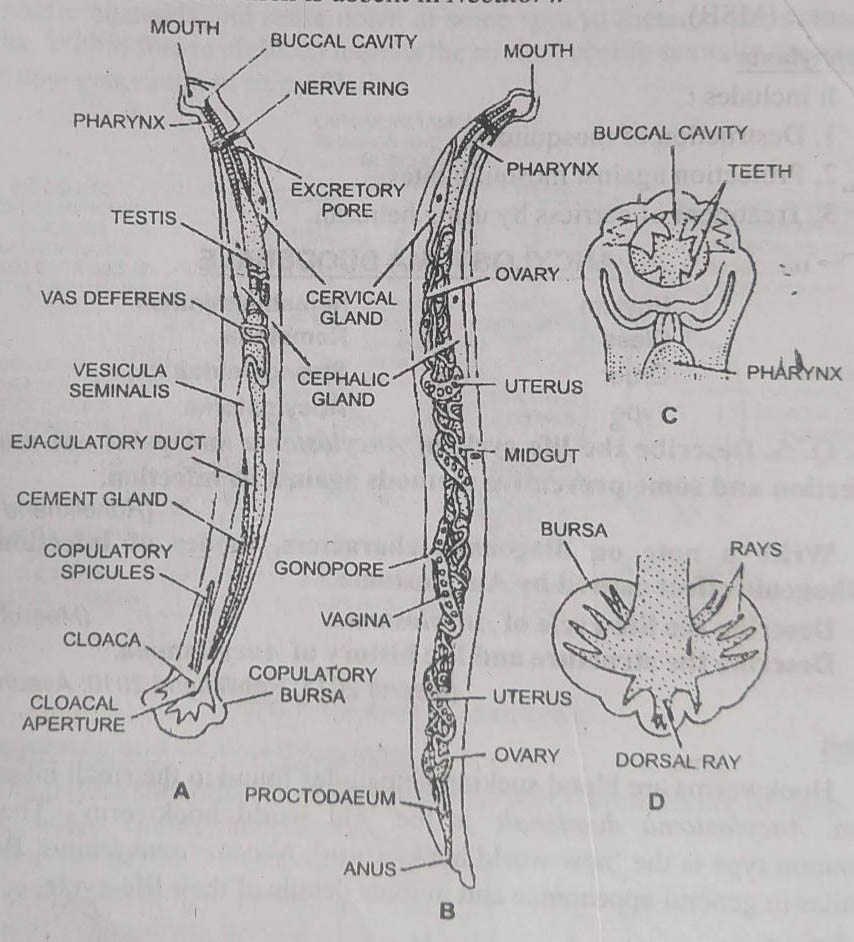Q. 5. Describe the life cycle of Ancylostoma and point out mode of infection and some preventive methods against its infection.
Write a note on diagnostic characters, modes of infection and pathogenic effect caused by Ancylostoma.
Describe the life-cycle of Ancylostoma.
Describe the structure and life history of Ancylostoma.
Habit
Hookworms are blood sucking nematodes found in the small intestine of man. Ancylostoma duodenale is the ‘old world hookworm’. The other common type is the new world hook-worm’, Necator americanus. Both are similar in general appearance and in most details of their life-cycle.
Distribution
Hookworm infection occurs in most tropical and subtropical parts of the world where proper hygienic conditions do not exist. A. duodenale dominates in Europe, North Africa, Western Asia, Northern China and Japan.
Structure
The mature worm is almost cylindrical and white or grey in colour. The male is slightly smaller than female. The male is 7.8 mm in length and 0.4-0.5 mm in width, the female is 10-13 mm long and 0.6 mm broad.
The anterior end is narrow and is slightly bent. It bears a large cup-shaped buccal capsule for attachment to the intestinal wall. The buccal capsule has two chitinous plates, bearing teeth. Hookworm sucks blood by the sucking action of pharynx.
The posterior end of male is broad and with an umbrella-like structure, called bursa. The bursa is supported by fleshy bursal rays of definite arrangement. The posterior end of female is bluntly pointed and ends in a minute caudal spine (which is absent in Necator).

Digestive System
The digestive system includes a straight tube. The pharynx is suctorial and has a triradiate lumen. In its wall are embedded three pharyngeal glands. Pharynx opens into the intestine which leads into a short rectum. The food includes cells of mucous membrane of host’s intestine, blood cells and serum.
Excretory System
The Excretory system consists of two canals embedded in the two lateral chords and an isthmus situated in the pharyngeal region. There is a single testis in male but ovaries are paired in female. The genital tubes in both the sexes are long and coiled. In female, the cloacal aperture is situated at the posterior end.
Life Cycle
Fertilisation is internal and during copulation the bursa of male is applied on the vulva of female. The female Ancylostoma lays about 20,000 eggs per day. Each egg is about 60 x 30u. These are passed along the host faeces at four-celled stage and do not develop further until exposed to air. Under favourable conditions the embryo hatches out of the egg in less than 24 hours in the faeces contained in mud.
The hatched larva is called the first rhabditiform lava’. It represents the first larval stage. It has mouth, pharynx and a simple intestine. It feeds on bacteria and organic debris in the faeces and grows rapidly. At the end of second day, it undergoes first moult and changes into second stage larva or the ‘strongyliform larva’. At about 5th day, it undergoes second moult to become filariform juvenile. This is the infective non-feeding stage. The skin of second stage larva is retained as a protective sheath. The larvae live in the upper half inch of the soil.
Distribution: Hook-worm infection occurs in most tropical and subtropical parts of world where proper hygienic conditions do not exist. Dudodenale domainate in Europe, North Africa, Western Asia, Northern China and Japan.
Infection: The third larval stage or the filariform juvenile represents the infective stage. It may remain alive in the moist soil for nearly four months without feeding. When man walks bare-footed on the infected soil, the larva penetrates the skin. Infection can also occur by ingestion of infective juvenile in food or drink.
The larvae burrow in the skin until they enter a lymph or blood vessel. These are carried by the blood stream to the lungs. Here these ascend trachea and reach throat. From glottis these are swallowed and settle down in small intestine. Soon after, these undergo moulting and change into third form. Thereafter, it grows and attains sexual maturity to start the cycle again.
Pathogenicity: Hookworm is the most pathogenic parasite of man in America it was called “american murderer”.
1. In skin: The penetrating larva causes ‘ground itching, or ‘water sore’ characterised by itching and inflammation of skin.
2. In lungs : the migratory larvae when in large number cause haemorrhage and bronchial pneumonitis.
3. In intestine: Adults in the intestine produce stomach pain, abdominal discomfort, nausea, food fermentation, diarrhoaea, but principal effect is anemia due to constant sucking of blood. It causes palpitation of heart, eosinophilia and even collapse.
Hookworm infection in children causes reatarded mental and physical growth and sometimes leads to dissiness, insomnia, optic illusion, general nervousness and fidgety movements.
Chemotherapy: Thymol, oil of chemopodium, tetrachlorethylene, carbon tetrachloride and hexylresorcinol are admistered to eliminate worms from the body. Hexylresorcinol is found to be most effective.
Prevention of soil by proper sanitary disposal of human faeces and hygenic way of living are the only preventive measures.
BSc 1st Year Lower Non-chordates Helminths Sample Model Practice Question Answer Papers
BSc 1st Year Sample Model Practice Mock Test Question Answer Papers